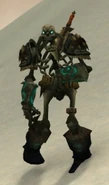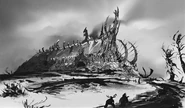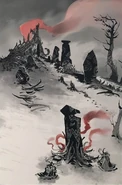
|
This article concerns content exclusive to Battle for Azeroth.
|
The Drust[2][3] (sometimes written in lower case)[4] were a large, hardy race who lived in Drustvar before the coming of humans in Kul Tiras. The Drust were slain by the human invaders, but did not depart Azeroth, instead remaining as spirits in the area. Over time, the Drust have slowly been trying to make their way back to the mortal world.[5]
The Drust made a pact with Lady Waycrest, and she accepted their aid in getting a stronger seat on Kul Tiras's council. On the Drust's part, all they desired was vengeance against her people.[5]
Background[]
Before the reign of Gorak Tul, the Drust practiced druidism. In the opinion of the druids, Gorak Tul's twisted ways brought disgrace to the Drust.[6]
Around 2,700 years ago, humans from Gilneas arrived on an island that they would later call Kul Tiras.[7] The Drust already lived on the island when the humans arrived, and from Drustvar they enacted raids against the humans' fledgling hamlets.[8] The Drust barbarians attacked the human settlers unprovoked. When the humans landed they tried peace but the Drust went to war immediately, and only a few tolerated new neighbors. They glorified the slaughter, attacking unarmed civilians.[1] Not all of the Drust agreed with the war. Members of the order of the Thornspeakers left the Drust to join Kul Tiran society. Some of the humans' Kul Tiran descendants heard the call of the wilds and sought to learn the ancient ways, and so the Drust Thornspeakers taught them the ways of druidism.[9]
The Drust assaults carried on for many years, until the humans of House Waycrest decided something had to be done and began a war against the Drust. But though the Waycrests were hearty folk, the Drust's druidic death magic[10] was strong and the humans began to lose the war.[8] House Waycrest researched their magic and created the Order of Embers to fight them.[11] To counter the Drust magic, the Order of Embers used weapons of silver.[12]
In time the Drust would be forced to withdraw as they lost numbers to the human settlers. When their great leader Gorak Tul ran out of living warriors, he conducted a ritual to create stone constructs to fight for him as part of his desperation to win. Colonel Arom Waycrest (who would later become a Lord) led the humans' final assault on the Drust and stabbed Gorak Tul himself. As he was stabbed Gorak Tul's power was broken and with it his connection to his stone constructs, which shattered.[1] But though wounded and broken, Gorak Tul did not die.[13]
In modern times, the story has been warped. The modern Kul Tirans believe that the stone constructs were used for a longer period than just near the end of the war, that Arom had killed Gorak Tul, and that Gorak Tul's living army fell soon after his death instead of earlier on.[1]
The Drust would live on as spirits, trying to return to the physical world.[5] The Waycrests had wiped out the Drust, but could not destroy Gorak Tul. For countless years he waited to enact his vengeance from within Thros,[14] until Lady Waycrest provided the means.[15] Stricken with grief due to her ailing husband, Lady Waycrest called out to any power that could save him. Gorak Tul answered her cry and promised that death would never part the couple, for a price.[16] Gorak Tul taught the Drust's ancient death magic[17] to Lady Waycrest, who in turn formed the Heartsbane Coven. The coven's magic awakened the remaining stone constructs[8] and stirred the Drust's spirits, causing some to raise as skeletons.[18] Other Drust spirits were put into wicker golems.[19]
But Lady Waycrest was merely a vessel for Gorak Tul's power, and her death opened the Rupture, the doorway for the Drust to enter Azeroth.[15] At the Rupture Gorak Tul was able to raise his people from the dead, but he was slain nonetheless. With his death the Heartsbane Coven was broken and Drustvar was released from Gorak Tul's power.
Culture notes[]
- Tomes were often kept by the strongest of the Drust, preserving the incantations of their magics and serving as conduits for harnessing their power. Scholars have tried to translate the ancient language transcribed within these tomes, only to find themselves going mad as they furthered their understanding of what had been written.[20]
- The Drust would often use various animals in their rituals, mostly for their organs. Bonesaws were pivotal in breaking through some of the larger animals' rib cages in order to extract the heart of the beast.[21]
- When the Drust wished to enchant the minds of their enemies, or prey, they would often do so subtly by leaving small tokens around their targets. Curious objects, when focused on by the holder, would summon a haunting vision of a dancing spectre. This spectre would entrance all who watched it, rendering them docile and easy to dispatch.[22]
- Many tools have been discovered that the Drust used in their rituals. One such tool was a sickle, used for ripping through the bellies of their sacrifices, spilling their entrails and allowing the Drust to use their organs in dark rituals.[23]
- Used to inflict doubt in the enemies of the Drust, this fetish was paramount for twisting the minds of their enemies. Those afflicted would question their motivations, their ideals, or their courage and would often find themselves at the end of a Drust blade before finally rediscovering their resolve.[24]
- Used for both combat and ancient ceremonies, the blades of the Drust are fearsome objects. When wielded by a Drust, this blade can quickly find it's way into any vital organ within a matter of seconds.[25]
- As the Drust became more skilled at trapping souls within objects, so did they become more adept at creating constructs of death in which to trap the souls. Revenants are amongst the fiercest of these creatures. Their bodies constructed from pieces that can no longer decompose, these creatures never tire and will hunt their prey for all eternity.[26]
- When the Drust were first learning to attach souls into constructs, they used the bones of their dead as hosts. Once the ritual was complete, these fetishes were said to glow with an eerie blue glow, presumably with the essence of the soul's power made manifest.[27]
- When a soul is called from the afterlife, it is free to roam the material realm if it is not restrained within moments of its arrival. The Drust created prisons for these souls for later use in their dark rituals, during which time the soul would suffer within, become a twisted version of what it once had been.[28]
- Since time immemorial, the Drust have used runes to shape their magics. This remains true of the spells woven by Gorak Tul and his ilk.[29]
Known Drust[]
- Notable
 Gorak Tul
Gorak Tul Ulfar
Ulfar Korvash
Korvash
- Types
Notes & trivia[]
- In the Battle for Azeroth alpha, Drust used a mix of human and vrykul models wearing primitive outfits.
- The Old Drust Road and Gol Thovas in Tiragarde Sound and Fate's End in Stormsong Valley show that the Drust's presence on Kul Tiras spread further than Drustvar.
Gallery[]
Speculation[]
This article or section includes speculation, observations or opinions possibly supported by lore or by Blizzard officials. It should not be taken as representing official lore.
|
- Drust may have been related to vrykul. The concept art shown at BlizzCon 2017 resembles a tattooed, slouched vrykul wearing animal fur and limbs. The concept art showing Drust architecture also greatly resembles vrykul architecture from Wrath of the Lich King concept artwork. Moreover, their buildings and structures are etched with multitudes of runes resembling Stormheim's runes and patterns and have vrykul aesthetic. Their giant and revenant stone constructs are also engraved with vrykul-like runes and patterns.
References[]
- ^ a b c d Quest:Pieces of History
- ^ Battle for Azeroth Preview: Drustvar Visitor's Guide
- ^ Quest:To Falconhurst!
- ^ Quest:Silver Blades
- ^ a b c 2017-05-11, BlizzCon 2017 Jeremy Feasel Interview – World of Warcraft: Battle for Azeroth. Blizzplanet, accessed on 2017-11-05
- ^ Quest:The Old Bear
- ^ World of Warcraft: Chronicle Volume 1, pg. 133
- ^ a b c Quest:The Ruins of Gol Var
- ^ Ulfar#Quotes
- ^ BlizzCon 2017: The Art of World of Warcraft, 2:50
- ^ Quest:The Order of Embers
- ^ Quest:A Lesson in Witch Hunting
- ^ Quest:Drustfall
- ^ Gorak Tul (tactics)#Adventure Guide
- ^ a b Waycrest Manor: Gorak Tul's speech after Lady Waycrest's death
- ^ Lord and Lady Waycrest#Adventure Guide
- ^ BlizzCon 2017: The Art of World of Warcraft, 2:50
- ^ Quest:If Bones Could Talk
- ^ Quest:Controlling the Situation
- ^ Ancient Runebound Tome
- ^ Ceremonial Bonesaw
- ^ Dance of the Dead
- ^ Disembowling Sickle
- ^ Fetish of the Tormented Mind
- ^ Jagged Blade of the Drust
- ^ Restored Revenant
- ^ Ritual Fetish
- ^ Soul Coffer
- ^ Quest:Buried Power
| ||||||||||||||||||||||||||||||||||||||||


